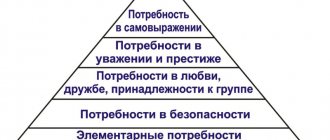What are needs
The key word in defining the concept of need is “need”.
Need
- this is the need for certain things, objects of the material world, objects, people, social indicators, in the absence of which a person feels uncomfortable.
Taking into account this definition, neediness, in order to become a need, must meet the following criteria:
- A lack of need causes a feeling of dissatisfaction. A need is something desired, a good.
- Accompanying with emotions: from negative at the first stage to joyful after the need is fulfilled. When we really want something, we get nervous and anxious; when we get what we want, we relax.
- Fixation on the subject of need. Consciousness snatches from reality those things that can satisfy us. For example, if we are hungry, we will focus on the food and the smell of food.
The system of needs is also formed according to special rules:
- Need is common to all living beings on the planet. But the more developed the species, the higher the level of needs. The tree has enough nutrients from the soil, sunlight, and rain watering. Man, as a highly developed animal, needs much more.
- The older the person, the more extensive the list of what is required. A baby can do without things that an adult needs.
- Needs are a strictly hierarchical structure, some are primary, others are secondary.
People's actions are dictated by the presence of a certain need, which is the main motivator of activity. Motivation to get what you want moves a person forward and forces him to act. Everything that has been created by people throughout the history of mankind in politics, economics, art, science is the result of activities to satisfy needs.
The inability to fulfill needs can lead to dependence on their importance for the individual and to the following various consequences:
- Physical death of a person
. If the need for food, sleep, water, air, safety, etc. is not satisfied. - Frustration
is a long-term experience associated with a nervous disorder and can lead to serious psychological problems. An example is the lack of recognition of a person’s merits by society. - Sublimation
- the transition of the energy of dissatisfaction into creation, creativity. For example, the absence of sex is replaced by heavy sports activities.
Thus, needs should be listened to and efforts should be made to realize them.
What needs does a person have?
Man is one of the representatives of the animal world, with instincts and needs inherent in other species. At the same time, we have higher intelligence, feelings, and strong-willed qualities. This combination causes the presence of needs at two levels: basic and additional (primary and secondary).
Basic Needs
This group is vital for humans as a biological species. Basic needs are divided into two groups.
| Physiological | Existential |
| Breathing, nutrition, thirst, sleep, rest, procreation, housing. | Comfort, social and legal security, availability of employment, etc. |
Physiological basic needs must be satisfied first, since without them existence itself is impossible. The listed things and phenomena have been inherent in man since primitive times.
A person tries to make the process of satisfying basic needs more comfortable. If at the initial stage of the development of the human race animal skins served as clothing, today a whole industry is working to clothe us.
Basic needs can change with age in favor of the predominance of some over others. Sleep, for example, is more important for young children and older people, but in our youth we are able to get by with minimal hours of rest and still feel alert. Sex, as a primary need, can also, for a number of reasons, lose priority with age, but in adolescence it is a priority.
Questions often arise about security as a necessity for existence. Man has always experienced danger from phenomena in the surrounding world or from other people. A tsunami, a collapse of glaciers, an attack by wild animals or other tribes - all this forced a person to defend himself or run away. Over time, entire institutions were formed that were supposed to protect the individual from external incursions (army, police, Ministry of Emergency Situations). That is why safety is a primary need; we must understand that our lives and property are protected and protected.
The needs of existence (existence) appear as an individual grows up and determines his place in society.
Secondary needs
If a group of primary needs is necessary for survival and is laid down at the genetic level, then secondary needs determine a certain level of a person’s quality of life and come and are transformed with life experience.
Among the secondary needs in theory, the following are identified:
- Spiritual
. These include the need to obtain new knowledge about the world, the search for the meaning of life and one’s place in it, the development of creative abilities, and the desire for harmony. - Social
– love, friendship, interaction with other people, feeling part of society, a separate social group (class, work team, family). - Prestigious
. We are talking about the need for recognition of our successes, worthy self-esteem, respect from other members of the communities in which we belong.
Thus, primary needs are innate and determined by physiology, while secondary needs are psychological in nature and develop throughout life.
PRIMARY NEEDS are physiological in nature and, as a rule, innate.
Examples include the need for food, water, breathing, sleeping and sexual needs. SECONDARY NEEDS are psychological in nature. For example, the needs for success, respect, affection, power and the need to belong to someone or something. Primary needs are genetically determined, while secondary needs are usually recognized through experience. Because people have different backgrounds, people's secondary needs vary more than their primary needs. [p.363] Needs are the conscious absence of something that causes an urge to action. Primary needs are genetically laid down, and secondary needs are developed in the course of cognition and gaining life experience. [p.384] National food security is an important component of national-state security and, as such, characterizes the economic stability and political independence of the existing system, its ability to provide the basic, primary needs of its citizens without prejudice to national-state interests. Therefore, the concept of food security has two aspects. [p.87]
In addition, social protection of vulnerable segments of the population is considered from the point of view of satisfying primary needs (according to A. Maslow), and social protection of university employees is considered not only primary, but also secondary, more essential needs. “They work not just for a paycheck, but to serve the highest national interests. Money, prestige, comfort are not the main thing for such people. And there are many such workers, which is confirmed by research data. For many employees, values such as respect for people (92.4%), creative work and self-realization of abilities (87.3%), reputation (64.4%) are of priority importance” [29]. [p.343]
In Fig. Figure 18 shows hypothetical curves of need and demand for a certain product. In the first part of the graph, up to the point (k, the need exceeds the demand - the principle of the primacy of need is triggered. This is also explained by the following factors [p.132]
Primary needs are often satisfied with money. But money motivates action (according to Western experts) only 30-50% of work [p.119]
Motivation is of great importance for workers engaged in scientific activities. In this regard, an important role is played by the classification and analysis of motivating factors, as well as the study of individual behavior as a function of his perceptions and expectations associated with a given situation. It should be borne in mind that, along with the primary needs that are satisfied with the help of money, there are more elevated needs - for knowledge, authority, creativity. Moral ideals, great goals, moral beliefs, habits, traditions, etc. are often of decisive importance to scientists. [p.140]
Having studied the market and settled on any specific suppliers, the purchasing department is obliged to determine the needs of the enterprise or firm for specific supplies. Determining needs is based on an inventory management strategy, which is covered in a special section in the textbook. In this chapter we outline only the basic principles for determining needs. First of all, identifying needs means identifying goods and services based on their quality, quantity, mainly in two methods by determining needs based on orders and systematically determining needs based on expenses. Determination of requirements based on orders, for example in mechanical engineering, occurs by decomposing specifications into individual components, taking into account existing stocks. The primary needs here are the needs for finished products, the secondary needs are for the units from which the products are assembled, and the tertiary needs are for the parts that make up the units. The timing of meeting subsequent needs is determined based on the timing of the previous purchases. [p.95]
Needs are classified according to certain criteria. Thus, a distinction is made between primary and secondary needs. Primary needs are those needs that a person experiences in any situation because their satisfaction is vital (for example, food, water, clothing, etc.). Secondary needs are those that arise with the development of civilization (for example, refrigerators, televisions, cars). In addition, a distinction is made between individual and social needs. Individual are those needs that a person experiences as an individual. People feel social needs as members of society. For example, food and water are individual needs, while the needs are for social order, justice, etc. —- social. Typically, a person himself ensures that his individual needs are met by buying, for example, food and clothing from other people. At the same time, the government or other public organizations (parliament, city council, etc.) ensure satisfaction of the public [p.52]
American researcher A. Maslow divided the entire set of needs into two groups: primary and secondary needs. In turn, Maslow divided the primary needs into physiological, the need for safety and security. [p.65]
There are also natural (objective) and artificial (subjective) conflicts. Natural conflicts arise as a result of a spontaneous combination of circumstances, aggravation of relations between groups of people regarding the satisfaction of their primary needs; artificial conflicts are created by people to achieve certain goals. [p.125]
Primary needs are physiological in nature and, as a rule, innate. These include the needs to breathe, sleep, eat, and sexual needs. [p.112]
Because of this, primary needs are genetically determined, and secondary needs are usually recognized through experience. Needs cannot be directly observed and measured. Needs serve only as a motive for action. They can be judged by people's behavior. When a need is felt by a person, it induces a state of aspiration in him. [p.113]
Maslow arranged all these needs in the form of a strict hierarchical structure (pyramid). In this case, the needs of the first and second levels are classified as primary needs, and the subsequent ones (third - fifth level) are classified as secondary needs. Maslow's hierarchy of needs is shown in Fig. 4.9. [p.115]
There are also primary and derived needs. In the classical school, primary needs are called needs, and derivatives are called needs. [p.32]
Primary needs are innate in nature, they are genetically determined. These are the needs for food, water, the need to breathe, sleep, the need for communication. [p.211]
Feelings are a form of consumers’ representation of their incentives for behavior in the market, a form of their awareness of their primary needs. It is important to note that the true feelings of people (and many organizations) do not depend on them and are not under their control. Sensations are in all cases something derivative, secondary from stimuli and are determined only by them. For example, a person in a supermarket cannot control his visual reaction to the display of goods, their packaging, etc., since the general visual perception of objects does not depend on the person (unless he is blind, of course) (he sees as many products as are located nearby ). [p.209]
Requests and preferences are a set of options for satisfying primary needs that arise in the consumer under the influence of sensations. The consumer can still make a choice, decide on [p.209]
Physiological needs consist of the basic, primary needs of a person for food, clothing, housing, etc., i.e. those needs that a person must satisfy in order to maintain physiological processes in the body. To manage people who consider it necessary to satisfy these needs first and foremost, it is important that a minimum wage ensures survival. [p.172]
To some extent, such structures carry a touch of subjectivity, although they help firms consciously regulate the process of promoting goods. Thus, it is believed that advertising based on the primary needs of people is more effective in promoting a product to the consumer. [p.80]
The division of needs into two groups is quite arbitrary. The fact is that a person’s primary needs are not exclusively physiological. For example, a person needs food in order to maintain his existence; however, for a significant part of people, it is not indifferent to what exactly they eat; buying delicacies or visiting an expensive restaurant are not physiological needs; they are social in nature. [p.176]
Needs are divided into primary and secondary. Primary needs are usually innate. These include the physiological needs of the body for food, water, sleep, breathing, etc. [p.82]
As a criterion for determining the essence of a person, two types of passion are called. Passions of the first type are of biological origin and apply to all people. These are the elementary, primary human needs for safety, shelter, food, etc. They have biological roots. [p.405]
The argument for income equality is the principle of utility maximization. The fact is that consumers spend their income first on those goods that have the greatest utility. After primary needs are satisfied, the remaining income is spent on goods with lower marginal utility. Therefore, the optimal distribution of income means distribution equally, which ensures the maximum possible total utility in society. In addition, the state's income equalization policy is socially attractive. [p.185]
Needs are usually divided into primary, which satisfy vital human needs (food, clothing, etc.), and secondary, which include all other needs (for example, leisure needs, cinema, theater, sports, etc.). Primary needs cannot be replaced by one another, but secondary needs can. The division into primary and secondary needs is historically arbitrary; the relationship between them changes with the development of society. [p.14]
Needs are satisfied in a certain order. Physiological and safety needs are primary needs that must be satisfied before higher-level needs can determine behavior. For example, an increased feeling of hunger puts the need for food at the center of human behavior, pushing aside others (for example, satisfying the need for one’s own development). According to Maslow, if there are two equally strong needs, then the lower level need dominates. [p.264]
Primary needs are laid down at the genetic level and are of a physiological nature. [p.579]
LAND is the most important factor of production. This is due to the natural essence of man. In order to live, a person must satisfy his primary needs for food, clothing, and shelter. These needs can only be satisfied by using land as a factor of production. It should be noted that the term “land” is used in a broad sense. It covers not only arable land, forests, etc., but also minerals, water resources, etc. In this sense, land can be considered as a specific means of production, i.e. simultaneously both as an object of labor and as a means (tool) of labor. [p.60]
Primary needs are physiological in nature and, as a rule, innate. These are the needs for food, water, breathing, surrender, etc. Secondary needs are psychological in nature. For example, the need for success, respect, affection, power, the need to belong to someone or something. Primary needs are genetically determined, secondary needs are recognized through life experience. Because people have different backgrounds, people's secondary needs vary more than their primary needs. [p.195]
Primary needs are physiological in nature and, as a rule, innate. For example, the need for food, water, air. They are genetically embedded in the body. And secondary ones, for example, the need for success, for recognition of one’s importance, for communication, appear with the development of a person’s higher nervous activity and his consciousness, with the acquisition of experience and knowledge. Thus, generalizing the polar points of view of scientists and taking into account the generally accepted division of needs into primary and secondary, and also, paying tribute to the objective law of the rise of needs, we will highlight the main groups of needs as they are formed and consolidated in the human mind [p.10]
The human need to penetrate into the unknown and incomprehensible does not come naturally. It arises under the influence of a person’s practical activity, in the process of his work, active participation in political, social and creative life. Even the need, for example, for food can trigger the process of cognition if, in order to satisfy it, a person needs to set and solve some pressing problems (for example, where to buy ginger root and smoked omul, what to cook for lunch), i.e. the primary need becomes cognitive. [p.15]
Douglas McGregor proposed two opposing styles of relationships between leaders and subordinates, called Theory X and Theory Y. According to Theory X, most people are lazy, avoid responsibility, are tightly attached to their primary needs, and therefore managing them is the lot of a select few who build their relationships with subordinates on the basis of threats, control and coercion. [p.46]
As a rule, primary needs are satisfied through economic methods, incentives (salaries of all types, benefits, subsidies, etc.). The effectiveness of economic methods depends on whether the following conditions are met [p.171]
All employee needs can be represented in the form of a certain structure. Primary ones are the basis for the formation of secondary needs of a higher order, the achievement of which makes it possible to satisfy and expand the range of primary needs to a greater extent. [p.118]
By associating with the external environment, ensuring the satisfaction of his own needs and desires, the individual consolidates the manifesting instincts in the form of primary needs that directly determine his activity (vector 12, Fig. 4.3.2). It is this activity that finally shapes the process of organization, perception and implementation by the individual of primary needs through sustainable motives (directory D, Fig. 4.3.2). [p.243]
Thus, models for providing the primary needs of an individual, quite fully studied and widely presented in the scientific literature [39,51], are based on genetically inherited instincts acquired and reinforced by everyone, the functions of formation and implementation of life activities. Their consistent improvement and associative application for other purposes and areas leads to the formation of a unified complex system of individual self-organization skills, implemented primarily in the process of studying the surrounding world. This, in turn, ensures the beginning of the stage of mastering the necessary knowledge, the content of which is consistently expanded and specialized throughout the entire life cycle of the individual [79, 85]. [p.249]
PRIMARY NEEDS - usually innate needs, such as the need to survive. [p.682]
PRIMARY NEEDS - psychological, usually innate needs, such as the need for self-preservation. [p.690]
Many customers are not satisfied with the paternalistic consciousness of the workers, according to which the workers are accustomed to not earn all the benefits - from bonuses to an apartment, but to receive them from the management, which, in turn, received it from the state. Customers predetermine wages that are far from being in the amount in which these benefits can be earned. After prolonged dissatisfaction with the current state of affairs, M.S.’s appeals become understandable. Gorbachev that it is necessary to take into account “the mentality of our people, who did not live in market conditions, knew only one form of property, located in a country where the state decided everything, where it was a kind of social security, where issues of personal, material interest were not clear” [1] . Without taking appropriate measures, the state abandoned to the mercy of those who for many years had been taught not to think, but to do only what was prescribed from above. Neither the management, nor especially the workers, have an economic consciousness. In the current situation, the lack of economic consciousness determined the market value of labor for construction workers. The cost of workers' labor was taken from the existing pre-reform wages in construction, taking into account indexation and without taking into account additional motivation. The wages of construction workers are determined by the market situation and cannot compensate for their motivational losses. Many workers realize hopelessness and continue their pre-reform behavior. A surprise for many workers was job instability, lack of finances to support their families and the fading opportunity to do anything on their own to improve their situation, and now many of them realize that in the current situation they were simply a tool that was needed at the time of their use. Many workers reduce the level of their needs, refuse to do work, “lump” and degrade. A worker needs significantly less finance to survive without work. In the absence of work or when refusing it, workers spend their time cultivating garden plots and collecting forests. It is possible for them to go to work if they do not have funds for basic needs, such as food, for example. The worker feels inferior to people who have financial resources, who, in turn, treat such an individual as a “slave” who does not need to be bought. “Slave” is ready for execution [p.32]
The first thing to note is the orientation of production towards direct consumption. Production is focused primarily on survival and satisfying primary needs - producing or earning more than necessary seems senseless and irrational. As the famous German sociologist M. Weber (1864-1920) puts it, a person simply wants to live the way he is used to and earn as much as is necessary for such a life. Production in excess of this causes a negative reaction, since the size and forms of consumption depend on a person’s place in the existing hierarchy and traditions. [p.40]
Types of needs
Needs can be classified on various grounds, of which there are quite a lot in the theory of psychology. The main types of division of needs are presented in the next section.
If we summarize all available theories, then we should distinguish three basic types of human needs.
Biological or physiological
Among the innate human needs laid down at the genetic level are the following:
- Food safety and taste characteristics.
- Comfortable external temperature and electromagnetic background.
- Clean water suitable for quenching thirst.
- Healthy ecology.
- Safety of life and home.
- Sexual satisfaction.
- Disposal of waste products.
These things are necessary for any living creature. This set of needs has practically not changed since the creation of the world, since from a physiological point of view, we are the same as millions of years ago. A person strives to realize them first and foremost and immediately.
Spiritual
Existential needs come from a system of universal human spiritual values, including: beauty, mercy, tranquility, harmony, peace, art. Each person has their own spiritual needs (as opposed to biological ones) and change over time and experience.
Among the spiritual needs are the following:
- The need for knowledge
. A mature person understands that in order to further grow, he must constantly learn. Moreover, expand the boundaries of existing skills and acquire new ones. People enter educational institutions to receive additional education, take advanced training courses, master new professions, and master the basics of painting and music. - The need for constant work on oneself, improving one’s personality (self-improvement)
. By satisfying this need, we quit smoking, go on a diet, get rid of toxic people and harmful emotions. A person thinks about how he would like to see himself after a certain period of time and strives for this. - The need for love and personal happiness
. The vast majority of people dream of having a loved one of the opposite sex nearby and creating a stable family. Many have been searching for many years, this need is so strong.
The realization of spiritual needs can be carried out through the simplest things. For example, a person goes into nature and sits with a fishing rod, fishing. At this time, he reflects, calms down, acquires spiritual harmony, satisfying his need for peace and making plans for the future.
Social
This type of needs is aimed at understanding one’s place in society and is associated with groups of people, social and economic activity.
Examples of social needs:
- Personal identification
. A person positions himself as a part of society with common traits inherent in society or a separate group. At the same time, he recognizes himself as an individual unit with a set of specific qualities and characteristics. - Self-affirmation
. We want to be satisfied with ourselves, with the actions and deeds that we perform. It is also important for a person to feel significant in society, to enjoy respect and approval from other people.
- Altruistic aspirations
. The individual takes pride in actions aimed at helping and assisting other people or living beings. He needs to be needed, useful, even in conditions of abandoning his own interests.
All of these types of needs are interpenetrating, they complement each other, some follow from others. For example, having satisfied the spiritual need to acquire a profession, we strive to achieve success in work for which we will be praised, and this is already a social need.
BASICS OF MANAGEMENT
to contents
Psychologists say that a person experiences a NEED
when he feels physiologically or psychologically a lack of something. Although a particular person at a particular time may not have a need in the sense of consciously feeling it, there are certain needs that every person can feel. Content theories of motivation represent attempts to classify these universal human needs into certain categories. There is still no universally accepted identification of certain needs. However, most psychologists agree that needs can in principle be classified as primary and secondary.
Rice. 33. A simplified model of motivation of behavior through needs.
PRIMARY NEEDS
are physiological in nature and, as a rule, congenital.
Examples include the need for food, water, breathing, sleeping and sexual needs. SECONDARY NEEDS
are psychological in nature. For example, the needs for success, respect, affection, power and the need to belong to someone or something. Primary needs are genetically determined, while secondary needs are usually recognized through experience. Because people have different backgrounds, people's secondary needs vary more than their primary needs.
NEEDS AND MOTIVATIONAL BEHAVIOR
. Needs cannot be directly observed or measured. Their existence can only be judged by people's behavior. Psychologists, observing people, have determined that needs serve as a motive for action.
When a need is felt by a person, it awakens in him a state of aspiration. Urge is a feeling of lack of something that has a certain direction. It is a behavioral manifestation of a need and is focused on achieving a goal. Goals in this sense are something that is perceived as a means of satisfying a need. When a person achieves such a goal, his need is satisfied, partially satisfied or unsatisfied. For example, if you feel the need for a challenging job, this may motivate you to try to achieve the goal of getting a job that provides it. Once you get such a position, you may find that the work there is actually not as difficult as you thought. This may cause you to work less hard or look for another job where your need will be satisfied. In Fig. 33. shows this type of behavior.
The degree of satisfaction obtained from achieving a goal influences a person’s behavior in similar circumstances in the future. In general, people tend to repeat behavior that they associate with need satisfaction and avoid behavior that is associated with insufficient satisfaction. This fact is known as the LAW OF RESULTS
.
Paul Lawrence
and
Jay Lorsch
o.
Continuing our example, we note: if you see that by setting yourself a task, you satisfy your need for meaningful work, you will strive to look for similar tasks in the future.
Because needs motivate people to seek their satisfaction, managers must create situations that allow people to feel that they can satisfy their needs through the type of behavior that leads to the achievement of organizational goals. For example, remember what was given in Chap. 3 describes a situation where the introduction of long seam mining technology in coal mines destroyed independent work groups and deprived miners of close interpersonal relationships. This is an example of how characteristics of the work situation and associated tasks can influence need satisfaction. The new technology also did not give the miners a sense of completion and meaningfulness in the work they were doing, because with the new method, each miner performed only a small part of the overall coal mining process. Consequently, people did not have the opportunity to demonstrate all their abilities. As a result, production discipline worsened, absenteeism and labor turnover increased, and labor productivity decreased. These problems disappeared when the administration changed the production process so that technology no longer conflicted with people's needs.
THE DIFFICULTY OF MOTIVATION THROUGH NEEDS
.
It is important to note that not all workers have a high need for achievement and independence and are similar to the miners in the example described above. All people have different fingerprints, and people's characters are a combination of very different traits. It follows that there is a huge variety of specific human needs, those goals that, according to each person, lead to the satisfaction of his needs, as well as types of behavior in achieving these goals. Analyzing this problem, Stephen Carroll
and
Henry Tosi
note:
“The structure of a person’s needs is determined by his place in the social structure or previously acquired experience. Consequently, there are many differences between people regarding the needs that are important to them. What is more important is that there are many ways and means to satisfy a particular type of need. For example, one person's need for self-affirmation can be satisfied by recognizing him as the best employee in the department. And to satisfy a similar need of someone else means recognizing the style of his clothes as the best, declaring to everyone that he dresses better than others in the group. The specific way in which a person can satisfy his specific need is determined by him based on his life experiences. We learn through experience that some situations are more desirable (rewarded) than others, and we strive for them. We try to avoid other situations.”
Thus, creating jobs with more challenge and greater responsibility has a positive motivational effect for many workers, but not for all. A leader must always keep in mind the element of chance. There is no one best way to get motivated. What works for motivating some people may not work for others. In addition, organizations by their nature complicate the practical theory of individual-oriented motivation. Interdependence of jobs, lack of information about the performance of individuals, and frequent changes in job responsibilities due to improvements in technology all add to the complexity of motivation.
Classifications of needs
Theoretical psychology offers many classifications of needs. We have already discussed one of them above: physiological, social and spiritual, these are the main groups of needs.
Foreign researchers did not so much classify needs as offer a specific list of them.
Examples:
- G. Murray
- achievements, aggression, independence, sex, creativity, understanding, respect, self-knowledge. - A. Pieron
- novelty, hedonism, communication, competition, mutual assistance and others (more than 20 types in total); - E. Fromm
- significance, self-affirmation, communication, affection, self-identification.
Some scientists have identified so-called neurotic needs as a separate group, the lack of satisfaction of which can lead to mental illness. These include: lack of social and interpersonal justice, the need for support and empathy, recognition, and possession.
In Russia, a classification of needs has been adopted, which divides them into the following levels:
- Based on the nature of the emergence of needs - natural and cultural
. - Depending on the area of application - communicative
(communication with other people),
cognitive
(the need to acquire new knowledge),
labor needs
, etc. - In relation to the object to which the need is directed - biological, material, spiritual and social
. - Correlating to their origin - endogenous
(determined by internal factors) and
exogenous
(depending on external conditions).
As we see, the number of human needs is numerous; today there is no complete list of them; there are only generalized groups and types. The most famous theory that places all types of human needs in order of priority is Abraham Maslow's Hierarchy of Needs.
The psychologist drew a whole pyramid, where needs are indicated in ascending order. This is what she looks like.
Maslow assured that until a person has satisfied the needs of the widest part of the pyramid, he will not strive to receive benefits from the higher levels. For example, if a person is hungry, then he has no time for public recognition. He considered hunger not only in relation to food, but also to sleep, thirst, sex, etc.
Maslow’s rule does not work in the opposite direction: an individual who has fulfilled the need for respect and recognition still needs food and sleep.
Food and lodging
The next two needs can be interchangeable and change their place of relevance depending on whether they are satisfied or not. Therefore, these two needs are food and shelter.
In general, a person will not seek shelter if he is mortally hungry, and yet protecting the elements goes hand in hand with immediate survival. What happens if there's a hail storm or you're in heavy snow? You will not look for food in such situations, even if you are hungry.
Thus, shelter is the next important necessity for a person to survive. This category also requires heat
. It will not survive more than a few days in sub-zero temperatures, even if it has food but no shelter or protection. There is a certain balance when it comes to the temperature that keeps the body healthy.
Body temperature that fluctuates below or above these degrees puts the body into survival mode. A stronger deviation leads to death. Then the best body temperature is 98.7 degrees Fahrenheit. 7 degrees below you lose consciousness. 7 degrees lower and the body can no longer regulate internal heat. At 82 years old, complete muscle degradation is observed and, finally, at 79 years old.
However, on the other hand, if your body temperature rises to 107 degrees, you will suffer neurological damage. Over 111 degrees causes the brain to overheat, ultimately leading to death. All of these scenarios can be avoided with adequate protection from cold or heat. It is hypothesized that cold conditions can reduce body fluids (and lead to dehydration) as quickly as warm weather conditions.
When we talk about the body's internal temperature, we must also consider the temperature outside and how human bodies survive degrees too low or too high. It is known that the body can adapt to certain changes, but this must happen gradually. For example, 140 degrees Fahrenheit (60 degrees Celsius) combined with extremely humid conditions can cause death after 10 minutes of exposure. This condition is called hyperthermia.
When it comes to cold weather, people are generally well equipped and temperatures of -29C can be acceptable with appropriate clothing. But there is rarely cold air there. Winters are usually accompanied by wind. How do we add y#8216; Wind chill coefficient ', the previous temperature may feel like -45 with only a light breeze. Add a little more (25 mph) and it's like -66. This is when exposed skin suffers from freezing within a few minutes.
Apsley Cherry-Garrard tells her story of -47 F (-43 C) leaving her mittens to grab a rope (with her own hands). He did the job in a few minutes, and it was only a few hours later, when he was already inside, in a warm room, that he saw a few blisters on his fingers. This is a superficial freezing and only damages the skin layer. This is not dangerous as the damaged skin falls off and new skin grows. But this is a good example of the ease with which low temperatures can damage the body.
On the other hand, if you are, for example, in cold water (near freezing level), you can survive for no more than 30 minutes. Since cold affects proper blood circulation, there is not enough oxygen to reach your brain. This causes drowsiness and can lead to even faster death and hypothermia.
As we said earlier, nutrition
It is also part of the basic survival needs. In general, the average person can live more than a month without food (sometimes even more). This survival period depends on several things: fat reserves, muscle mass and the condition of the internal organs.
During fasting, the process is as follows. In the first 3 days, the body uses only fat reserves. Depending on this, this period may be longer or shorter. The body then enters the ketone stage, where it uses fat stores in the liver called ketones (fatty acids). The body not only uses liver reserves, but can also resort to intestines. This is one of the reasons why it is difficult to feed someone without creating more problems.
The intestinal walls and muscles are damaged due to the long period of fasting and have not yet been restored to function properly. This process takes about 2 weeks. This again depends on individual reserves.
The last stage is when the body eats the muscle. It really doesn't matter what kind of muscle it consumes, but it ends up causing damage to the heart muscle. As a result, the heart weakens and can no longer pump blood. Then it just goes away. Literally, the body eats itself to prolong life at the expense of the body itself.
It is often neglected, but a person can die during a famine not because of it, but because of its toxicity. Typically, the liver is the organ that processes toxins. To eliminate them, you need nutrients to break down and neutralize these toxins. If a person goes through the process of fasting without nutrients entering the body, the liver does not have the ability to process and decompose toxins and finally quits. This quickly leads to a painful death.
However, we must note that most people who suffer from these conditions do not die from starvation, but from infections. The body's natural defenses are decomposed. The body cannot maintain its own defense systems if it does not have the fuel (nutrients) to do so. Typically the individual suffers from swelling in the abdomen or swelling of the extremities. This means fluid collects in certain areas of the body (mainly the abdomen and extremities). As a result, infectious diseases attack the body and ultimately lead to death.
Formation of human needs
Taking into account the considered classification of needs, we can talk about the features of their formation. Basic physiological needs are innate, transmitted to us at the genetic level. A person lives with them until his death; without receiving them, he dies physically.
Such needs cannot be prohibited or imposed by force. Primary needs cannot be good or bad, pure or dirty. Only ways and methods of satisfying them can be considered unworthy. For example, a person uses a public space instead of a toilet.
Primary spiritual needs also appear with a person. The presence of love, close people, harmony, and self-realization in life are mandatory for his mental health. Of course, without the listed benefits, a person will not die, but he will be stuck in reflection and frustration for a long time.
Secondary needs are formed in an individual in several stages.
Infancy
All the physiological needs of the baby are provided by his parents. Since the child has contact with adults, social needs arise even before six months: he smiles, looks at rattles, identifies mother and father.
Earlier childhood
At about the age of 3 years, the baby develops an understanding of objects to satisfy needs - he realizes the need for toys, certain food, specific clothing. Cognitive needs grow, the child reads books, sculpts, draws, and actively explores the world.
Preschool period, primary school age
Children's social environment expands significantly. In addition to mothers and grandmothers, they have their own friends - children from kindergarten, class, yard or clubs where he begins to go. The need for communication, recognition, mutual assistance and understanding is formed.
Teenagers
At this age, the last physiological need is revealed - sexual. For the first time, such secondary needs as self-realization and self-improvement are formed. There is a sharp change and expansion of cognitive interests. A teenager strives to learn about those things and objects that he did not even think about in the early periods of his life.
On the basis of the formed sexual need, a need for a person of the opposite sex and romantic experiences appear. The need for communication is shifting towards peers and friends. Relatives fade into the background.
It is believed that by the end of adolescence, all the basic needs of a person have already been developed. Their further development occurs through changes in their content and methods of achievement.
The importance of needs in human life
Needs have a great influence on the development of personality and the characteristics of human activity. Needs underlie all types of human activity, including his activities. Therefore, needs and motives influence the effectiveness of human activity. The effectiveness of activities is influenced by the following main factors related to human needs:
- Strength of need: the quality of activity is best with average strength of need and deteriorates with too weak or too strong motivation.
- The content of the needs underlying the activity: if the activity directly satisfies the need underlying it, then the effectiveness of the activity increases. For example, if the professional activity of a medical worker is based on the desire to help other people, then his activity will be more effective than if his activity is based on material needs.
In the process of carrying out activities, a person’s personality develops. Therefore, the level of psychological development of a person as an individual is determined by the number, variety and hierarchy (subordination) of a person’s needs. Man differs from animals in that he has more needs than animals, and these needs are much more diverse. Animals have only organic needs and some needs related to ensuring the physical safety of the body, while humans also have material, social, creative, spiritual needs, as well as mental development needs. Each of these groups of needs can, in turn, be represented by many private needs included in the corresponding group. Thus, the number and degree of differentiation of needs that a person has can serve as a characteristic of the level of his psychological development.
An even more important characteristic of a person’s level of development is the diversity of his needs. But even more than the total number and variety of existing needs, a person as a person is characterized by which of his needs are primary and which are secondary. If, among the many needs he has, a person primarily pays attention to satisfying his organic needs, then we are unlikely to be dealing with a psychologically highly developed personality. But if a person’s creative or spiritual needs come first in importance, then he really is a highly developed personality.










